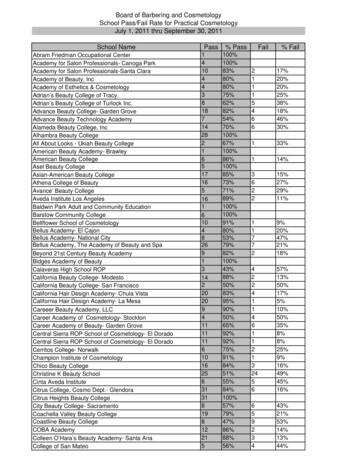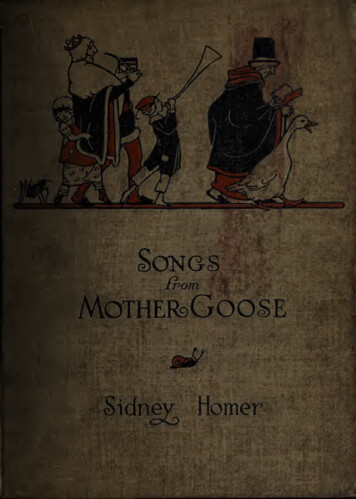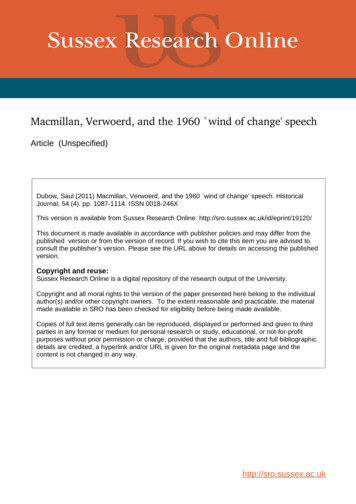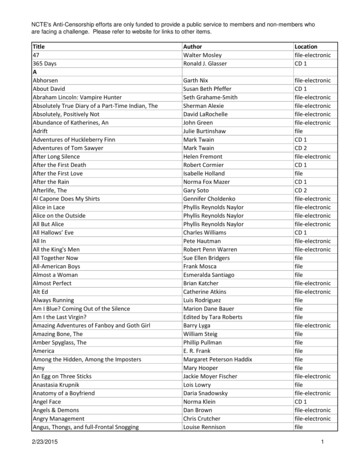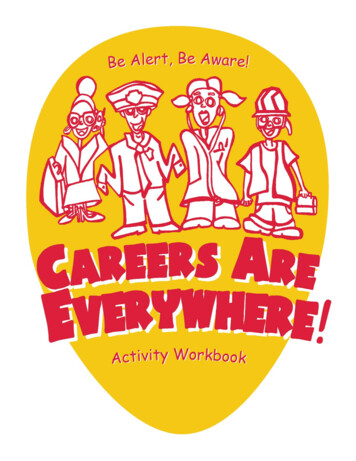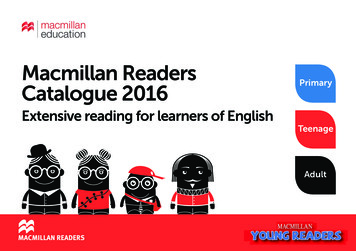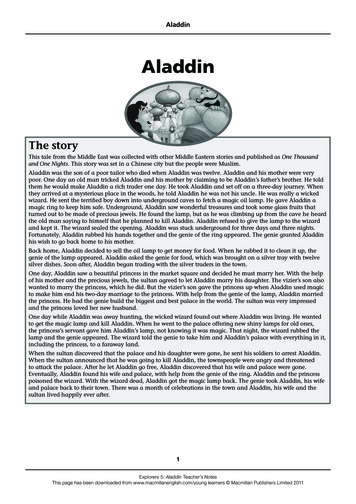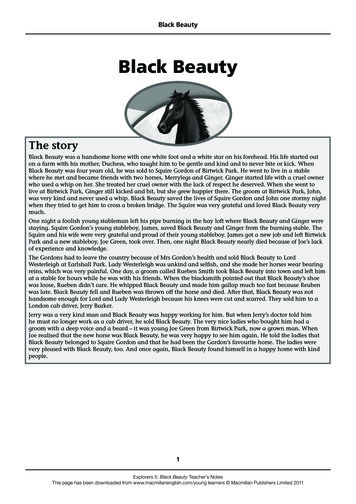
Transcription
Black BeautyBlack BeautyThe storyBlack Beauty was a handsome horse with one white foot and a white star on his forehead. His life started outon a farm with his mother, Duchess, who taught him to be gentle and kind and to never bite or kick. WhenBlack Beauty was four years old, he was sold to Squire Gordon of Birtwick Park. He went to live in a stablewhere he met and became friends with two horses, Merrylegs and Ginger. Ginger started life with a cruel ownerwho used a whip on her. She treated her cruel owner with the lack of respect he deserved. When she went tolive at Birtwick Park, Ginger still kicked and bit, but she grew happier there. The groom at Birtwick Park, John,was very kind and never used a whip. Black Beauty saved the lives of Squire Gordon and John one stormy nightwhen they tried to get him to cross a broken bridge. The Squire was very grateful and loved Black Beauty verymuch.One night a foolish young stableman left his pipe burning in the hay loft where Black Beauty and Ginger werestaying. Squire Gordon’s young stableboy, James, saved Black Beauty and Ginger from the burning stable. TheSquire and his wife were very grateful and proud of their young stableboy. James got a new job and left BirtwickPark and a new stableboy, Joe Green, took over. Then, one night Black Beauty nearly died because of Joe’s lackof experience and knowledge.The Gordons had to leave the country because of Mrs Gordon’s health and sold Black Beauty to LordWesterleigh at Earlshall Park. Lady Westerleigh was unkind and selfish, and she made her horses wear bearingreins, which was very painful. One day, a groom called Rueben Smith took Black Beauty into town and left himat a stable for hours while he was with his friends. When the blacksmith pointed out that Black Beauty’s shoewas loose, Rueben didn’t care. He whipped Black Beauty and made him gallop much too fast because Reubenwas late. Black Beauty fell and Rueben was thrown off the horse and died. After that, Black Beauty was nothandsome enough for Lord and Lady Westerleigh because his knees were cut and scarred. They sold him to aLondon cab driver, Jerry Barker.Jerry was a very kind man and Black Beauty was happy working for him. But when Jerry’s doctor told himhe must no longer work as a cab driver, he sold Black Beauty. The very nice ladies who bought him had agroom with a deep voice and a beard – it was young Joe Green from Birtwick Park, now a grown man. WhenJoe realised that the new horse was Black Beauty, he was very happy to see him again. He told the ladies thatBlack Beauty belonged to Squire Gordon and that he had been the Gordon’s favourite horse. The ladies werevery pleased with Black Beauty, too. And once again, Black Beauty found himself in a happy home with kindpeople.1Explorers 5: Black Beauty Teacher’s NotesThis page has been downloaded from www.macmillanenglish.com/young learners Macmillan Publishers Limited 2011
Black BeautyIntroducing the bookThe contents pageThe coverlHold up the cover. Read the book’s title toand with the class.lTalk about the picture. Ask What do you thinkthe story is going to be about? What is the horsedoing? Where is the horse? Why is the horsecalled Black Beauty?lAsk the children to turn to the contents page.Explain that the Contents list tells us what isin the book.lAsk How many chapters are there? Read thechapter titles to and with the class. Brieflyexplain any unfamiliar words (most will becovered in the chapter notes). Ask thechildren what page each chapter starts on.lPoint out that at the end of the book there isa poem (on pages 74–75) and someinformation about a hospital for animals(beginning on page 76).lDraw attention to the border pictures. AskWhat do you see in the bottom right corner?(hay) What is to the left of the hay? (a saddle)What is to the left of the saddle? (brushes) Whatis above the brushes? (a bridle) Ask about thehorseshoe, halter, bit and reins.lAsk questions about each chapter title tostimulate the children’s interest, for example:The title pagelAsk the children to turn to the title page. AskWho is the author?lExplain that this is a classic story that hasbeen adapted (made simpler) by anotherwriter.lAsk Who wrote the original story? (There issome information about the author onpage 79.) Ask Who adapted the story?l– Chapter 4: What do you think happens in thischapter?– Chapter 8: Where do you think Black Beautywill go in this chapter?– Chapter 9: Do you think Black Beauty will behappy in this chapter?lTalk about the picture. Ask Do you think this isa young horse or an old horse? What colour is it?Do you think this horse has a nice life? Why?2Tell the children to do the related activity onpage 1 of their Workbook.You can play the audio download ofthe story at any time you choose.See www.macmillanenglish.com/younglearnersExplorers 5: Black Beauty Teacher’s NotesThis page has been downloaded from www.macmillanenglish.com/young learners Macmillan Publishers Limited 2011
Black BeautyChapter 1Birtwick ParkActive vocabularyPages 3 to 10bridledrop the ‘l’ to make a new wordfieldremind class of the rule for ‘i’before ‘e’ except after ‘c’gallopnote the ‘ll’ in the middlegentle‘g’ is soft and sounds like ‘j’groomnote the ‘oo’ in the middlehandsomean adjective usually used todescribe menreinsreins and rains are homophonessaddlenote the ‘dd’ in the middlestable‘le’ is a common word endingtrotrhymes with hotPassive vocabularybit blacksmith break in carriage coatfine manners master oats pony strapsBefore readinglPre-teach the active vocabulary (see Teacher’sNotes Introduction page 13 and the Glossaryon page 49). Use the notes in the table todiscuss any interesting features of the words.lAsk the children to do the activities onpage 2 of their Workbook to practise the newvocabulary.lPoint out that this story happened in the1800s before there were cars. It was a timewhen people travelled by horse. Ask thechildren what they know about riding ahorse.lRead the title of Chapter 1. Explain thatBirtwick Park is the name of a large countryhouse that has a lot of fields and trees roundit. Ask Who do you think lives in large countryhouses, rich people or poor? Do you think horseslike living in the country? Why?3Explorers 5: Black Beauty Teacher’s NotesThis page has been downloaded from www.macmillanenglish.com/young learners Macmillan Publishers Limited 2011
Black BeautylllllTell the children to look at the picture onpage 5. Ask What is the man doing? Is BlackBeauty older now? How do you know? Where arethey? Does the man look like a kind or unkindman?lRead the chapter expressively to the class (orplay the audio download). Do not stop toexplain anything or to ask questions. Ensurethe children are following in their books.lChoose whichever of the following options ismost appropriate for your class:– Read the chapter again and encourage theclass to read it with you.Tell the children to look at the picture onpage 7. Ask Where is Black Beauty? Whichhorse looks unhappy, the white horse or thebrown one? Which horse is the smallest? Whatdo you think their names might be?– Read the chapter again, a paragraph at atime, and ask the class (or individuals) toread each paragraph aloud after you.– Do not read again yourself. Ask groups orindividuals to read the chapter aloud, aparagraph at a time.Tell the children to look at the picture onpage 9 and to describe the picture. Ask Whodo you think the man and woman are? Do youthink the woman likes Black Beauty? Do youthink the man and woman have to work hard fortheir money?Tell the children that the story is told by thehorse, Black Beauty. Ask the children whatthey know about horses. Ask Do you thinkhorses have an easy life or a difficult life? Whatdo they need to be healthy and happy?lAsk the children if they have ever seen a filmof Black Beauty.lExplain that they are going to read about aman called Squire Gordon. In the past, asquire was a man who owned lots of land inEngland. He lived in a big house and he paidmen to work for him.lDuring readingTell the children to look at the picture onpage 3. Ask How many horses are there? Whichhorse is Black Beauty? What are the horsesdoing?lRead (or play) the chapter again, aparagraph at a time. Explain the meaningand pronunciation of the words listed aspassive vocabulary (and any otherunfamiliar words).lDiscuss how the pictures can help the readerguess the meaning of the text.Stage 1 comprehension (literal)Ask the questions orally, or set them asa written activity. You can also ask thechildren to do the activity on page 3 of theirWorkbook.Optional suggestion: you may wish to givethe children an appropriate amount of time,for example five minutes, to look quicklythrough the chapter to find (and perhapsunderline or copy) the active vocabulary theyhave been introduced to.1Whose first home was a large field with apond in the middle of it?2What did the young horse learn to eat?3What did the young horse do when hismother was working?4Did the young horse kick and bite?5What did Duchess tell her son about hisgrandparents?6Where did Black Beauty have some white onhim?4Explorers 5: Black Beauty Teacher’s NotesThis page has been downloaded from www.macmillanenglish.com/young learners Macmillan Publishers Limited 2011
Black Beauty7What did the young horse have to do forSquire Gordon?8Who said, ‘He’s a fine horse. I would like tobuy him.’?9What did master mean when he said, ‘I willbreak him in for you first.’?lAsk the children to find an example ofquestions and exclamations in the chapter.Draw attention to the punctuation. Read italoud, and draw attention to how your toneof voice changes.lAsk the children to find and read aloudexamples of words containing: ‘ei’, ‘ie’, ‘ai’,‘oo’, ‘oa’.lAsk the children to find and read aloud anywords containing a double consonant (forexample, middle). Discuss the meaning ofmerry in Merrylegs.lAsk the children to find and read aloudsentences with the past tense of: gallop, trot.Make sure they pronounce ‘ed’ like ‘t’ ingalloped and like ‘id’ in trotted.lFinally, ask individuals to re-read shortsections of the text aloud. Encourage them toread expressively and with appropriateintonation. (You might like to ask children toplay the role of particular characters andread their parts.)10 Why did Black Beauty’s master put a bridleon him?11 Where did the master put the bit?12 What was attached to the bit?13 What did the master put on Black Beauty’sback?14 What did the master do with the straps?15 What did Black Beauty have to get used to?16 What did the blacksmith do?17 Why did Black Beauty need heavy metalshoes?18 What did Black Beauty learn to wear?19 What did the blinkers do?20 Who did Black Beauty work with?21 Who lived at Birtwick Park?After reading22 What did the groom do when he jumped offBlack Beauty’s back?Stage 2 comprehension (extension)23 What did the groom give Black Beauty toeat?Ask these questions orally, or set them as awritten activity for the more able. Answerswill vary. Encourage the children to givereasons for their suggestions, and accept anyanswer they can justify.24 Who was in the loose box next to BlackBeauty?25 What did Merrylegs do for the children andMrs Gordon?1Why did Duchess tell her son that hisgrandfather was a champion racehorseand his grandmother was a good-temperedanimal?2Why do you think Squire Gordon looked atBlack Beauty’s legs, mouth and eyes beforehe bought him?3How did Black Beauty feel about beingbroken in by his master?4Why do you think the blacksmith nailed theheavy metal shoes to Black Beauty’s feet?26 Why did Ginger glare at Black Beauty?27 What did Ginger do to people? Why?28 Who is James? Is he kind to the horses?29 Who is John? Is he kind to the horses?30 Who obeyed the lightest touch on the reins?31 Who gave Black Beauty his name?32 Who let Black Beauty gallop a lot?5Explorers 5: Black Beauty Teacher’s NotesThis page has been downloaded from www.macmillanenglish.com/young learners Macmillan Publishers Limited 2011
Black Beauty5How did Black Beauty feel about wearing thecollar and the strap under his tail?lDiscuss what the children have discoveredabout Black Beauty in this chapter.6How do you think Duchess felt when BlackBeauty went away with Squire Gordon?l7How do you think Black Beauty felt when thegroom led him into a loose box?8How do you think Miss Jessie and Miss Florafelt about Merrylegs?9Why do you think Merrylegs is happy livingat Birtwick Park?Has anyone in the class ever moved house?Discuss what it was like moving into astrange house and not knowing any peopleor the area. How did it feel? What did thechildren find difficult? (If not many childrenhave had the experience, ask them toimagine what it would be like.)lAsk the children what they think of Ginger.Ask them if they have known children whokick or bite. Ask Do children and horses needpeople to show them kindness? How do horsesand some children behave when their young lifeis very unhappy? Do you think Black Beauty willbe friends with Merrylegs and Ginger?lWrite some of the words from the story onthe board and ‘forget’ to put in the vowels.Leave spaces for them. Ask the children tosupply the missing vowels.lPlay a rhyming game. Write these wordsfrom the chapter on the board: bite, box, kind,house, gate, name, oats, trot, strap, tail.Brainstorm as a class, and write down on theboard, as many words as possible that rhymewith each word.lElicit from the class anything they knowabout England – both country life and citylife.lWrite these words on the board: grandfather,racehorse, sometimes, forehead, blacksmith,stableboy. Then read them and ask thechildren which two words make up eachcompound word. Discuss the meanings of thewords. (Point out that in forehead, fore isactually a prefix that means front and so it isnot really a compound noun like the otherwords. Also you might want to explain thatin blacksmith, a smith is a person who workswith metal. A person who forges iron is ablacksmith.)10 What did Black Beauty learn about Gingerand why she bit people?11 How did Black Beauty feel about riders onhis back?12 How do you think Black Beauty felt whenMrs Gordon named him?13 Do you think Ginger liked pulling the squire’scarriage with Black Beauty?14 Which home do you think Black Beauty likedmost? Why?15 Which day of the week did Black Beauty likemost? Why?Stage 2 comprehension (extra)Characterisation Ensure that the childrenunderstand that the story begins with BlackBeauty telling about his first home whenhe was a young horse. At that time, hedid not yet have the name Black Beauty.The children should understand thatBlack Beauty comes from a good breed ofhorses and has been treated well. Discussthe characters introduced in this chapter:Black Beauty, Duchess (his mother), theirmaster (unnamed), Squire Gordon (masterat Birtwick Park), Mrs Gordon and herdaughters Jessie and Flora, Merrylegs,Ginger, James (the stableboy), John(the groom).6Explorers 5: Black Beauty Teacher’s NotesThis page has been downloaded from www.macmillanenglish.com/young learners Macmillan Publishers Limited 2011
Black BeautylWrite (–) on the board and tell the children itis called a dash. Point out that it issometimes used when the author wants toadd information or explain something shehas just written. Ask the children to find andread aloud sentences with dashes in thechapter. Discuss the use of the dash in eachsentence.lIf appropriate, try some Extension Activities(see Teacher’s Notes Introduction page 19).lAsk What do you think will happen next in thestory?7Explorers 5: Black Beauty Teacher’s NotesThis page has been downloaded from www.macmillanenglish.com/young learners Macmillan Publishers Limited 2011
Black BeautyChapter 2GingerActive vocabularybloodthe ‘oo’ is pronounced like ‘u’ inmud; blood is a noun and the verbis bleedPages 11 to 17crueltwo syllables: cru el (sounds likecroo – L)differentthe first ‘e’ is often incorrectly leftout by some children when spellingthis wordexcellentthe verb ‘excel’ is turned into anadjective by adding the suffix ‘ent’;‘c’ sounds like ‘s’ after ‘ex’fashionable the noun ‘fashion’ is turned into anadjective by adding the suffix ‘able’futuresounds like ‘few’ ‘cher’sweatrhymes with betterriblethe opposite is wonderfultrustrhymes with mustwash‘wa’ sounds like the ‘wa’ in waterPassive vocabularybucked carriage coachman enemieslimped mane patted pony rearedsnorted spurs treat whipBefore readinglPre-teach the active vocabulary (see Teacher’sNotes Introduction page 13 and the Glossaryon page 49). Use the notes in the table todiscuss any interesting features of the words.lAsk the children to do the activity on page 4of their Workbook to practise the newvocabulary.lAsk the class to recall what happened in theprevious chapter.lRead the title of Chapter 2. Ask What do weknow about Ginger?8Explorers 5: Black Beauty Teacher’s NotesThis page has been downloaded from www.macmillanenglish.com/young learners Macmillan Publishers Limited 2011
Black BeautyllllTell the children to look at the picture onpages 12 and 13. Ask Which horse do you see?What is she doing? What do you think happenedto the man? What has he got in his hand? Whathas he got on his boots? Do you think he is akind young man?Tell the children to look at the picture onpages 14 and 15. Ask Do you see Black Beautyor Ginger pulling a carriage with another horse?Where are they? What is the man in the carriagedoing? How does the horse feel? Are the manand woman poor or rich?Tell the children to look at the picture onpage 16. Ask Which horse do you see? Who doyou think the two girls are? What is the boy onthe horse doing? How do you think the horsefeels? How does the man feel?Why did Samson do most of the work on thefarm?5What did Samson tell people?6What did Ginger do to teach him a lesson?7What did Samson do with his sharp metalspurs?8What did Ginger do after she threw Samsonoff her back?9Who patted Ginger and fed her some oats?12 What did Ginger tell Black Beauty aboutbearing reins?13 How did Ginger feel about wearing a bit?Why?Optional suggestion: you may wish to givethe children an appropriate amount of time,for example five minutes, to look quicklythrough the chapter to find (and perhapsunderline or copy) the active vocabulary theyhave been introduced to.14 What did the coachman do if Ginger and theother horse didn’t stand still?15 What did the smart man from London careabout?16 What happened to Ginger after she ranaway?Read the chapter to and with the class.Follow the same procedure as you did forChapter 1 (see page 4) to help the childrenread and understand the text. Use the audiodownload, if you wish.17 Why did the next master sell her to SquireGordon?18 What did John understand about Ginger?19 Why did John tell Merrylegs to behave herselfin future?20 How did John feel when he saw the boy hitMerrylegs with a stick?Ask the questions orally, or set them asa written activity. You can also ask thechildren to do the activity on page 5 of theirWorkbook.2411 Who did Samson’s father sell Ginger to?Stage 1 comprehension (literal)1How did Ginger feel when Samson and theother man took her away? Why?10 What did Samson’s father say to him?During readingl321 Why didn’t Merrylegs kick the boy with thestick?22 Why did Sawyer’s pony turn to go in thegates at Birtwick Park?What did Samson do to Ginger when he tookher away from her mother?23 What did Squire Gordon tell Sawyer?What did the other man do to Ginger whenthey took her?9Explorers 5: Black Beauty Teacher’s NotesThis page has been downloaded from www.macmillanenglish.com/young learners Macmillan Publishers Limited 2011
Black BeautyllllAsk the children to find examples of peopleand animals speaking in the chapter. Drawattention to the speech marks and discusshow they are used. In each case, ask thechildren what the exact words were that werespoken. Elicit that these are the words that goinside the speech marks.Ask the children to find words with twosyllables, such as master, roughly, father,mother, bridle, saddle. Read the words aloud,tapping out or clapping the syllables as youread.Ask the children to find and read aloudproper nouns in the chapter. Elicit that eachbegins with a capital letter because it is theparticular name of a person or place.Ask the class to find and read aloud verbswhich end in ‘ed’ in the past tense where the‘ed’ sounds like ‘t’, for example pushed,whipped, kicked, bucked.lAsk the children to find adjectives in thechapter and say who or what they describe,for example kind master, old man, tired horse.lFinally, ask individuals to re-read shortsections of the text aloud. Encourage them toread expressively and with appropriateintonation. (You might like to ask children toplay the role of particular characters andread their parts.)How do you think Samson’s father felt abouthim and the way he treated Ginger?3Why do you think Ginger never saw Samsonagain? What happened to him?4What do you know about the smart manfrom London?5How do you think the coachman felt when hehad to sit for hours waiting for the master?Why do you think he treated the horsesbadly?6Why did Ginger tell Black Beauty, ‘All menare my enemies.’?7What lesson did Merrylegs want to teach theboy with the stick? Why?8Do you think Merrylegs wanted to kick theboy she threw off her back? Why?9How do you think Sawyer’s pony felt when hebegan to whip her?10 What did Squire Gordon think of Sawyer andhis pony?Stage 2 comprehension (extra)Plot Ask the children to list the main thingsthat happened in this chapter. Write theirideas on the board in the correct sequence,for example: Two unkind men, Samson andanother man, took Ginger away from her mother.Samson treated Ginger very badly. Samson toldpeople he was an excellent rider and Gingerwanted to teach him a lesson. Ginger threwSamson off her back and he cut her with hisspurs, and so on.After readingStage 2 comprehension (extension)Ask these questions orally, or set them as awritten activity for the more able. Answerswill vary. Encourage the children to givereasons for their suggestions, and accept anyanswer they can justify.12lHow old do you think Ginger was when thetwo men took her away from her mother?Why?Write these words on the board and ask thechildren to find and read aloud sentenceswith these words in them. Discuss howGinger felt about each and why: bridle, whip,spurs, oats, bearing rein, a bit.10Explorers 5: Black Beauty Teacher’s NotesThis page has been downloaded from www.macmillanenglish.com/young learners Macmillan Publishers Limited 2011
Black BeautylWrite these words on the board: a whip(noun), whipped (verb), a bit (noun), bit (pasttense of the verb ‘bite’). Ask the class to findand read aloud sentences with these nouns.Then ask the children to find and read aloudsentences with these verbs.lWrite Flies buzzed around me on the board.Ask Who said this? How did she feel about theflies? Why were they buzzing around her? Askthe children how horses try to get flies off ofthem. Explain that buzz is an onomatopoeicword (it sounds like the sound it describes).You might like to allow the children topretend they are bees buzzing around theclassroom!lWrite bad-tempered on the board. Ask Who isdescribed as bad-tempered in this chapter? (thegroom at the new place, Samson) What is theopposite of bad-tempered? Who is described asgood-tempered in Chapter 1? Explain thatsome, but not many, adjectives are made oftwo words that are hyphenated.lAsk the children what sort of things makethem angry or bad-tempered. Talk aboutways you can stop yourself from gettingangry or being bad-tempered.lIf appropriate, try some Extension Activities(see Teacher’s Notes Introduction page 19).lAsk What do you think will happen next in thestory?11Explorers 5: Black Beauty Teacher’s NotesThis page has been downloaded from www.macmillanenglish.com/young learners Macmillan Publishers Limited 2011
Black BeautyChapter 3The stormActive vocabularyaccidentthe first ‘c’ is a hard ‘c’ and soundslike ‘k’ but the second ‘c’ soundslike ‘s’Pages 18 to 24bridge‘g’ sounds like ‘j’busy‘u’ sounds like ‘i’ and ‘s’ sounds like‘z’ (bizee)cleverremember the phrase: you are everso clevercottagenote the ‘tt’ in the middleimmediately many adverbs end in ‘ly’levelthe two ‘e’s are level with ‘v’ butthe two ‘l’s are higherrespectother words with the root word‘spect’ include inspect, spectator,spectacularspreadfind the word read ‘hiding’ insidewhisperyou whisper in someone’s ear whenyou do not want others to hear youPassive readingdie down embarrassmentsave storm strokehitchrubBefore readinglPre-teach the active vocabulary (see Teacher’sNotes Introduction page 13 and the Glossaryon page 49). Use the notes in the table todiscuss any interesting features of the words.lAsk the children to do the activities onpage 6 of their Workbook to practise the newvocabulary.lAsk the class to recall what happened in theprevious chapter.lRead the title of Chapter 3. Ask What happenswhen there is a storm? What do you think willhappen to Black Beauty in this chapter?12Explorers 5: Black Beauty Teacher’s NotesThis page has been downloaded from www.macmillanenglish.com/young learners Macmillan Publishers Limited 2011
Black Beautyllll4Why did Squire Gordon say, ‘Let’s get out ofthis wood.’?5Why did Black Beauty stop immediately?6What did John say was the only thing theycould do?7What did John want Black Beauty to dowhen he saw the water on the bridge?8Why did Black Beauty refuse to cross thebridge?Tell the children to look at the picture onpage 23. Ask What has Squire Gordon got in hishand? Who is standing behind Squire Gordon? Isthe other person a man or a boy? Where arethey? What is Black Beauty doing?9What did the man in a nearby cottage tellJohn and Squire Gordon?Optional suggestion: you may wish to givethe children an appropriate amount of time,for example five minutes, to look quicklythrough the chapter to find (and perhapsunderline or copy) the active vocabulary theyhave been introduced to.11 Who saved whose life?Tell the children to look at the picture onpage 19. Ask What is the weather like? Where isthe tree? Why has Black Beauty stopped? Why isSquire Gordon holding his hat? Who is holdingthe reins? How do you think they feel?Tell the children to look at the picture onpage 21. Ask Where is Black Beauty now? Whatis John doing? What is Squire Gordon doing?How does Black Beauty feel? What do you thinkhas happened?10 What did the man in the nearby cottage dowhen he saw John trying to pull Black Beautyacross the bridge?12 What did Squire Gordon say to John as BlackBeauty trotted along the river bank?13 What did John do for Black Beauty whenthey returned to the stable that night?14 Who was John’s stableboy? Was he a goodworker?During readingl15 Who was Sir Clifford Williams and what washe looking for?Read the chapter to and with the class.Follow the same procedure as you did forChapter 1 (see page 4) to help the childrenread and understand the text. Use the audiodownload, if you wish.16 Did John think James was too young for thejob?17 What did John tell Squire Gordon aboutJames’s work?Stage 1 comprehension (literal)18 What did James have to learn?Ask the questions orally, or set them asa written activity. You can also ask thechildren to do the activity on page 7 of theirWorkbook.1Why was the river almost level with the littlewooden bridge?2When Black Beauty crossed the little woodenbridge on the way to town, how much waterwas on the road?3What did Black Beauty and John do whileSquire Gordon was in the office?19 Who helped James as much as possible onthe busy roads?20 What did James whisper?lTo demonstrate how important verbs are tothe meaning of the sentences, read some ofthe sentences from the chapter, omitting theverbs. Ask the class to supply the missingverbs. Remind the class that every sentencemust have at least one verb in it.13Explorers 5: Black Beauty Teacher’s NotesThis page has been downloaded from www.macmillanenglish.com/young learners Macmillan Publishers Limited 2011
Black BeautylAsk the children to find and read aloud anywords containing: ‘ow’, ‘au’ or ‘ou’.8How did James feel when Squire Gordon toldhim about the new job? Why?lWrite these words on the board: hitched,wheels, crashed, carriage, shoulder, whispered,accident, immediately. Ask the children howmany syllables are in each word and askthem to tap out the syllables as they read thewords.9Why did James have to learn to drive on busyroads?l10 How do you think Black Beauty felt whenJames was learning to drive the carriage?11 How do you think Black Beauty helped Jameson the roads?Finally, ask individuals to re-read shortsections of the text aloud. Encourage them toread expressively and with appropriateintonation. (You might like to ask children toplay the role of particular characters andread their parts.)12 How do you think James felt when hewhispered, ‘I don’t need John any more.’?Stage 2 comprehension (extra)Author’s style Point out how the chapter iswritten in two sections with a gap betweenthem. Explain that this is the way the authorshows the passing of time. The gap denotesthat some time has passed since the previoussection. Ask the children how much timethey think had passed (about two months).After readingStage 2 comprehension (extension)Ask these questions orally, or set them as awritten activity for the more able. Answerswill vary. Encourage the children to givereasons for their suggestions, and accept anyanswer they can justify.1How do you think Squire Gordon and Johnfelt when it began to rain again?2How do you think Black Beauty and John feltwhen they were waiting outside the office forSquire Gordon?3How do you think Black Beauty, SquireGordon and John felt when the tree crashedto the ground in front of them?4How did John feel after the man stoppedthem from crossing the bridge?5Do you think Squire Gordon thought thatBlack Beauty was a special horse? Why(not)?6Why did John give Black Beauty lots of oatsand a thick bed of straw that night?7What d
most appropriate for your class: – Read the chapter again and encourage the class to read it with you. – Read the chapter again, a paragraph at a time, and ask the class (or individuals) to read each paragraph aloud after you. – Do not read again yourself. Ask groups or indi
